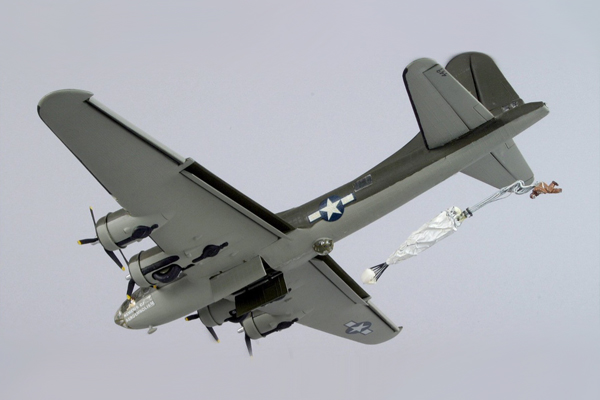USAAF Boeing B-17E Flying Fortress

MODEL BY:
H. Davidson
Model Scale:
1/72
MODEL ADDED:
06/15/1980
historical significance
First Albuquerque Visit: 1943
additional information
William Randolph Lovelace II (December 30, 1907 – December 12, 1965) was an American physician who made many contributions to the study of aerospace medicine. He studied medicine at the Harvard Medical School and graduated in 1934. His residences were served at New York’s Bellevue Hospital and the Mayo Clinic in Rochester, Minnesota.
Having an interest in aviation, Dr. Lovelace became Flight Surgeon with the rank of First Lieutenant in US Army Medical Corps Reserve. He also began studying the problems of high-altitude flight, and in 1938 the Aeromedical Field Laboratory located at Wright Field requested that he develop an oxygen-mask for use in high-altitude aircraft.
When the Boeing B-29 Superfortress was in the design phase, the aircraft was to be pressurized. but It was feared battle damage would depressurize the aircraft and a crew bail-out would become necessary. There was a concern with surviving a high-altitude bailout and that the crew could die before descending to 12,000 ft. During World War II, Dr. Lovelace began serving in the United States Army Air Forces. He personally performed experiments with the regard to the escape from pressurized aircraft and the use of the parachutes during high-altitude flights.
On 24 June 1943, Dr. Lovelace bailed out of a Boeing B-17E aircraft flying at 40,200 feet with an oxygen bottle sewn into his flight suit. After the parachute opened, he was knocked unconscious, and he suffered frostbite when one of his gloves was ripped off during the descent. Dr. Lovelace eventually recovered shortly before hitting the ground and his experiment proved to be successful. For this test, Dr Lovelace was awarded the Distinguished Flying Cross. In proving that his system worked, the B-17E Flying Fortress, 41-2407, aircraft was named the “Nemesis of Aero Embolism”.
In 1947 Dr. Lovelace and his wife moved to Albuquerque, New Mexico, where he joined his uncle at the Lovelace Clinic. Durning the late 1950’s and 1960’s, many famous aviators, test pilots, and NASA astronauts were medically tested at the Clinic. Later, Dr. Lovelace established the Lovelace Medical Foundation with his uncle. The facility is currently known as the Lovelace Respiratory Research Institute.
On December 12, 1965, Dr. Lovelace and his wife were flying in a private plane near Aspen, Colorado when the plane crashed into a canyon. Dr. and Mrs. Lovelace, along with their pilot, Milton Brown, aged 27, died at the crash site. The Lovelace’s are buried at the Fairview Memorial Park located in Albuquerque, New Mexico.
The model shows Dr. Lovelace bailing out of the B-17E and his parachute beginning to be deployed.
A photo of a similar type of B-17 that was used in the test.
Dr. Lovelace II in June 1943 is standing in front of the rear entry door on the B-17. The artwork as seen over his left shoulder is depicting the parachute test.
GALLERY:
SEARCH OUR DATABASE:
